Page 358 of 481
357 Practical hints
What to do if …?
ProblemPossible cause/consequenceSuggested solution
-The yellow ABS indicator lamp
comes on while the engine is
running.The ABS is temporarily not available. The
ESP® and the BAS are also unavailable.
The system’s self-diagnosis may not be
completed yet.
The brake system is still functioning normally
but without the systems specified above.
�Drive a short distance with added
caution at a vehicle speed of above
12 mph (20 km/h).
When the ABS indicator lamp goes
out, the ABS, the ESP
®, and the BAS
are available again.
If the ABS indicator lamp does not go out:
�Continue driving with added caution.
�Have the system checked at an autho-
rized Mercedes-Benz Center as soon
as possible.
Failure to follow these instructions in-
creases the risk of an accident.
Page 359 of 481
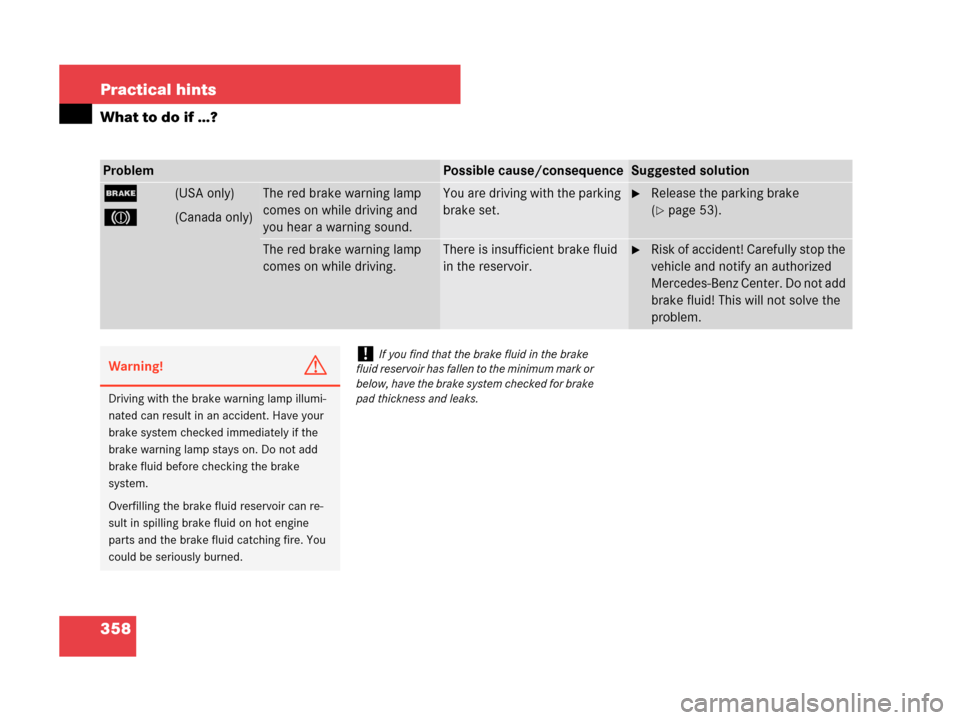
358 Practical hints
What to do if …?
ProblemPossible cause/consequenceSuggested solution
;
3 (USA only)
(Canada only)The red brake warning lamp
comes on while driving and
you hear a warning sound.You are driving with the parking
brake set.�Release the parking brake
(
�page 53).
The red brake warning lamp
comes on while driving.There is insufficient brake fluid
in the reservoir.�Risk of accident! Carefully stop the
vehicle and notify an authorized
Mercedes-Benz Center. Do not add
brake fluid! This will not solve the
problem.
Warning!G
Driving with the brake warning lamp illumi-
nated can result in an accident. Have your
brake system checked immediately if the
brake warning lamp stays on. Do not add
brake fluid before checking the brake
system.
Overfilling the brake fluid reservoir can re-
sult in spilling brake fluid on hot engine
parts and the brake fluid catching fire. You
could be seriously burned.
!If you find that the brake fluid in the brake
fluid reservoir has fallen to the minimum mark or
below, have the brake system checked for brake
pad thickness and leaks.
Page 360 of 481
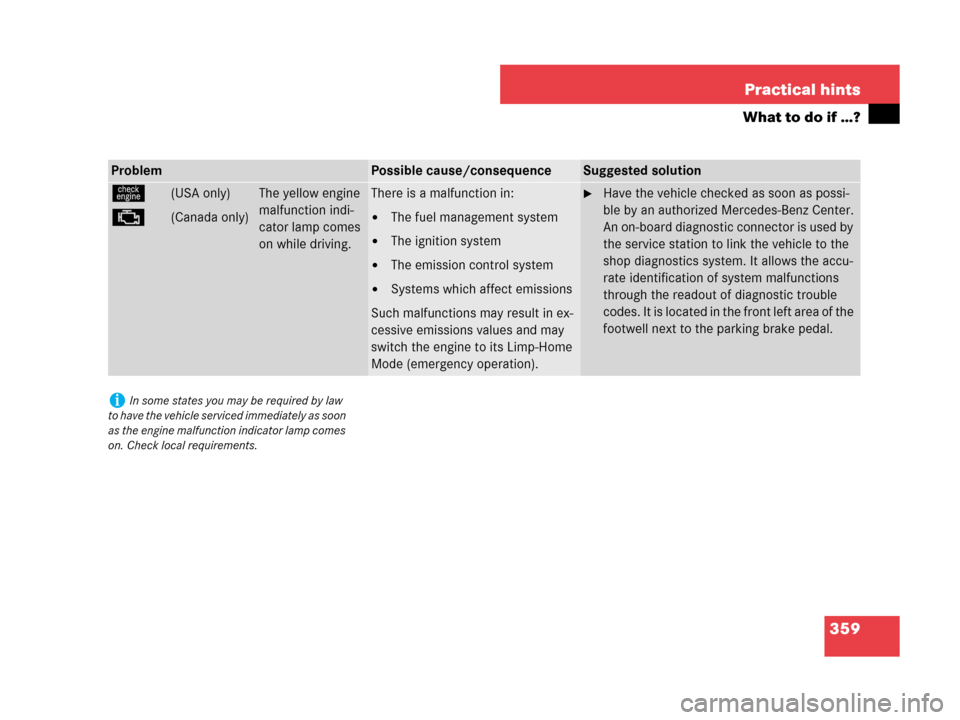
359 Practical hints
What to do if …?
ProblemPossible cause/consequenceSuggested solution
ú
±(USA only)
(Canada only)The yellow engine
malfunction indi-
cator lamp comes
on while driving.There is a malfunction in:
�The fuel management system
�The ignition system
�The emission control system
�Systems which affect emissions
Such malfunctions may result in ex-
cessive emissions values and may
switch the engine to its Limp-Home
Mode (emergency operation).
�Have the vehicle checked as soon as possi-
ble by an authorized Mercedes-Benz Center.
An on-board diagnostic connector is used by
the service station to link the vehicle to the
shop diagnostics system. It allows the accu-
rate identification of system malfunctions
through the readout of diagnostic trouble
codes. It is located in the front left area of the
footwell next to the parking brake pedal.
iIn some states you may be required by law
to have the vehicle serviced immediately as soon
as the engine malfunction indicator lamp comes
on. Check local requirements.
Page 361 of 481
360 Practical hints
What to do if …?
ProblemPossible cause/consequenceSuggested solution
ú
±(USA only)
(Canada only)The yellow engine
malfunction indi-
cator lamp comes
on while driving.A loss of pressure has been
detected in the fuel system. The fuel
cap may not be closed properly or
the fuel system may be leaky.�Check the fuel cap (�page 303).
If it is not closed properly:
�Close the fuel cap.
If it is closed properly:
�Have the fuel system checked by an autho-
rized Mercedes-Benz Center.
Your fuel tank is empty.�After refuelling, start, turn off, and restart the
engine three or four times in succession.
The Limp-Home Mode is canceled. You do not
need to have your vehicle checked.
Page 362 of 481
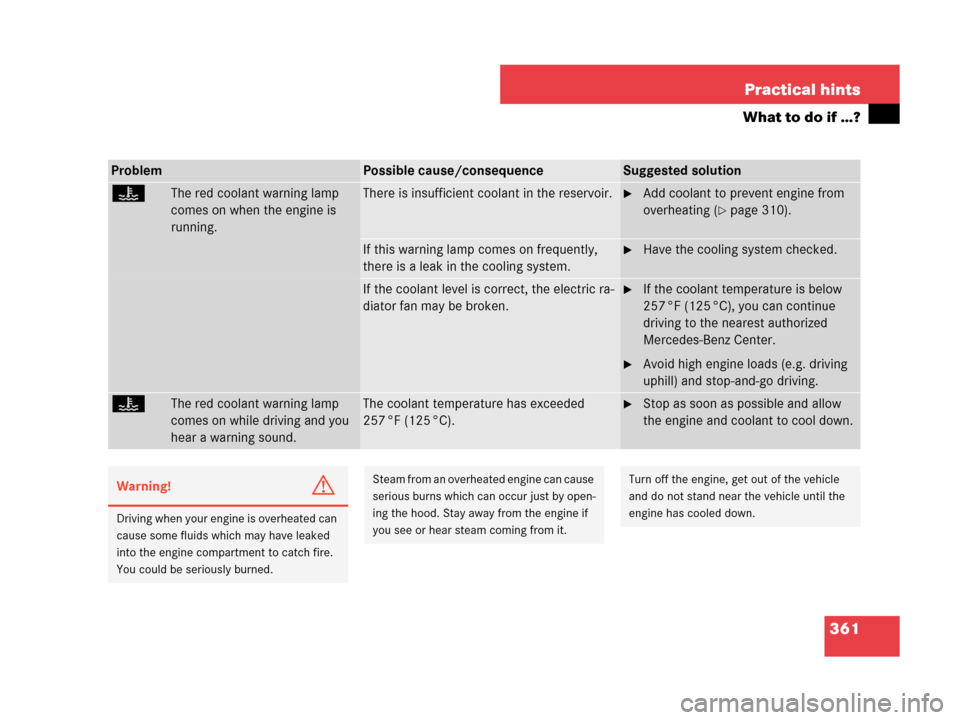
361 Practical hints
What to do if …?
ProblemPossible cause/consequenceSuggested solution
•The red coolant warning lamp
comes on when the engine is
running.There is insufficient coolant in the reservoir.�Add coolant to prevent engine from
overheating (
�page 310).
If this warning lamp comes on frequently,
there is a leak in the cooling system.�Have the cooling system checked.
If the coolant level is correct, the electric ra-
diator fan may be broken.�If the coolant temperature is below
257 °F (125 °C), you can continue
driving to the nearest authorized
Mercedes-Benz Center.
�Avoid high engine loads (e.g. driving
uphill) and stop-and-go driving.
•The red coolant warning lamp
comes on while driving and you
hear a warning sound.The coolant temperature has exceeded
257 °F (125 °C).�Stop as soon as possible and allow
the engine and coolant to cool down.
Warning!G
Driving when your engine is overheated can
cause some fluids which may have leaked
into the engine compartment to catch fire.
You could be seriously burned.
Steam from an overheated engine can cause
serious burns which can occur just by open-
ing the hood. Stay away from the engine if
you see or hear steam coming from it.Turn off the engine, get out of the vehicle
and do not stand near the vehicle until the
engine has cooled down.
Page 363 of 481
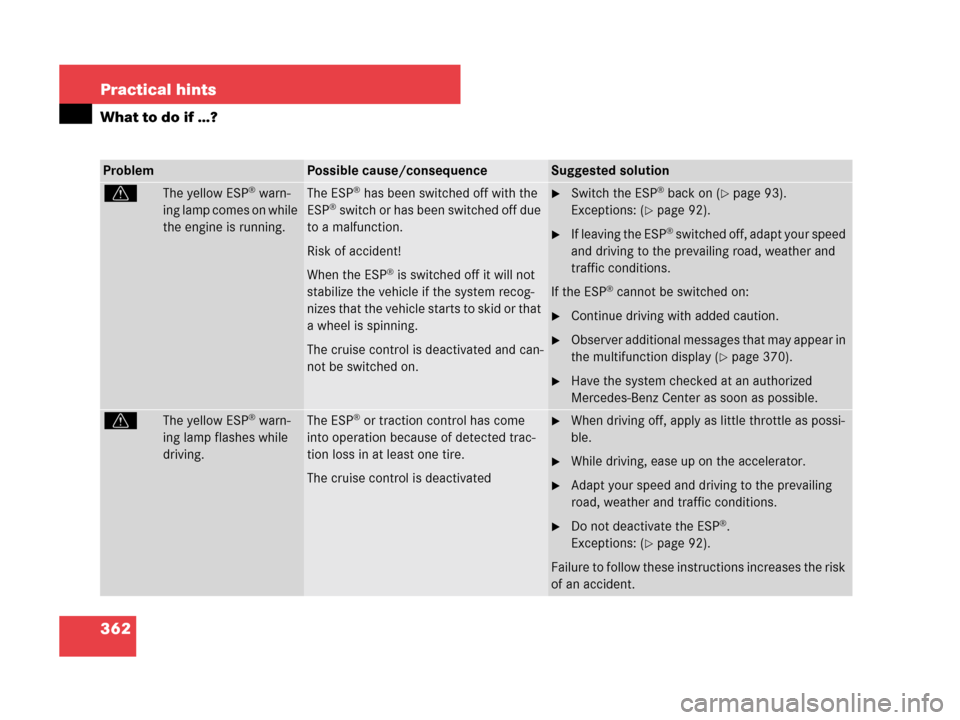
362 Practical hints
What to do if …?
ProblemPossible cause/consequenceSuggested solution
vThe yellow ESP® warn-
ing lamp comes on while
the engine is running.The ESP® has been switched off with the
ESP® switch or has been switched off due
to a malfunction.
Risk of accident!
When the ESP
® is switched off it will not
stabilize the vehicle if the system recog-
nizes that the vehicle starts to skid or that
a wheel is spinning.
The cruise control is deactivated and can-
not be switched on.
�Switch the ESP® back on (�page 93).
Exceptions: (
�page 92).
�If leaving the ESP® switched off, adapt your speed
and driving to the prevailing road, weather and
traffic conditions.
If the ESP
® cannot be switched on:
�Continue driving with added caution.
�Observer additional messages that may appear in
the multifunction display (
�page 370).
�Have the system checked at an authorized
Mercedes-Benz Center as soon as possible.
vThe yellow ESP® warn-
ing lamp flashes while
driving.The ESP® or traction control has come
into operation because of detected trac-
tion loss in at least one tire.
The cruise control is deactivated�When driving off, apply as little throttle as possi-
ble.
�While driving, ease up on the accelerator.
�Adapt your speed and driving to the prevailing
road, weather and traffic conditions.
�Do not deactivate the ESP®.
Exceptions: (
�page 92).
Failure to follow these instructions increases the risk
of an accident.
Page 379 of 481
378 Practical hints
What to do if …?
Symbol messages
Display symbolDisplay messagePossible cause/consequencePossible solution
#The battery is no longer charging.
Possible causes:
�broken poly-V-belt
�alternator malfunctioning
�Stop immediately in a safe location or
as soon as it is safe to do so and check
the poly-V-belt.
If it is broken:
�Do not continue to drive. Otherwise
the engine will overheat due to an
inoperative water pump which may
result in damage to the engine. Notify
an authorized Mercedes-Benz Center.
If it is intact:
�Drive immediately to the nearest
authorized Mercedes-Benz Center.
Low voltage
Charge batteryThe battery has insufficient voltage.�Start the engine (�page 50).
Low voltage
Switch off
consumersThe battery has insufficient voltage.�Turn off unnecessary electrical con-
sumers.
Page 380 of 481
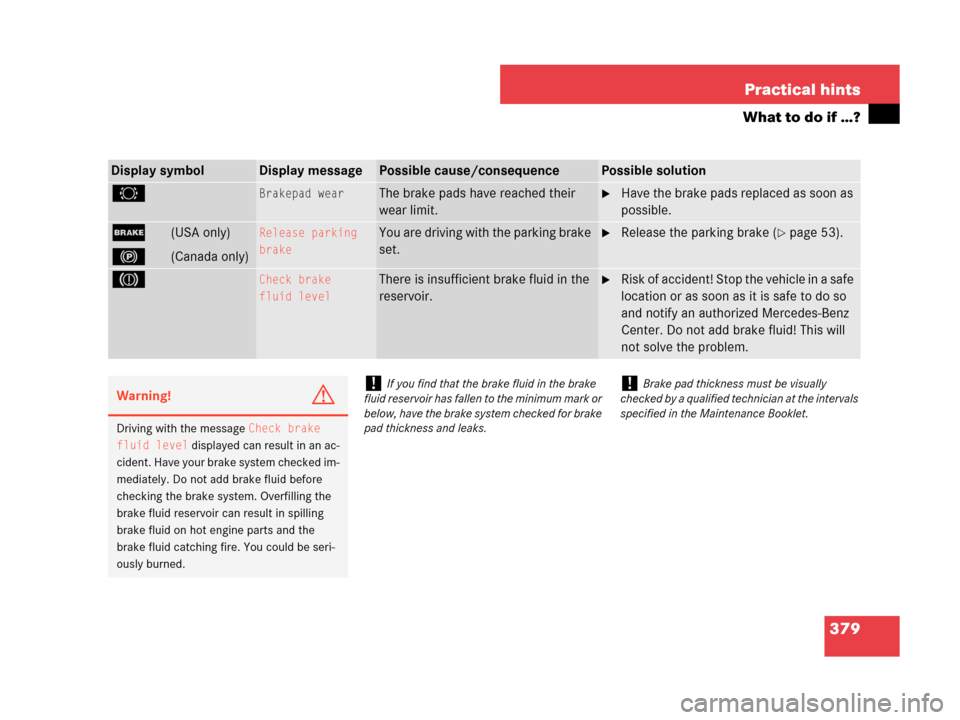
379 Practical hints
What to do if …?
Display symbolDisplay messagePossible cause/consequencePossible solution
2Brakepad wearThe brake pads have reached their
wear limit.�Have the brake pads replaced as soon as
possible.
;(USA only)
!(Canada only)
Release parking
brakeYou are driving with the parking brake
set.�Release the parking brake (�page 53).
3 Check brake
fluid levelThere is insufficient brake fluid in the
reservoir.�Risk of accident! Stop the vehicle in a safe
location or as soon as it is safe to do so
and notify an authorized Mercedes-Benz
Center. Do not add brake fluid! This will
not solve the problem.
Warning!G
Driving with the message Check brake
fluid level
displayed can result in an ac-
cident. Have your brake system checked im-
mediately. Do not add brake fluid before
checking the brake system. Overfilling the
brake fluid reservoir can result in spilling
brake fluid on hot engine parts and the
brake fluid catching fire. You could be seri-
ously burned.
!If you find that the brake fluid in the brake
fluid reservoir has fallen to the minimum mark or
below, have the brake system checked for brake
pad thickness and leaks.!Brake pad thickness must be visually
checked by a qualified technician at the intervals
specified in the Maintenance Booklet.